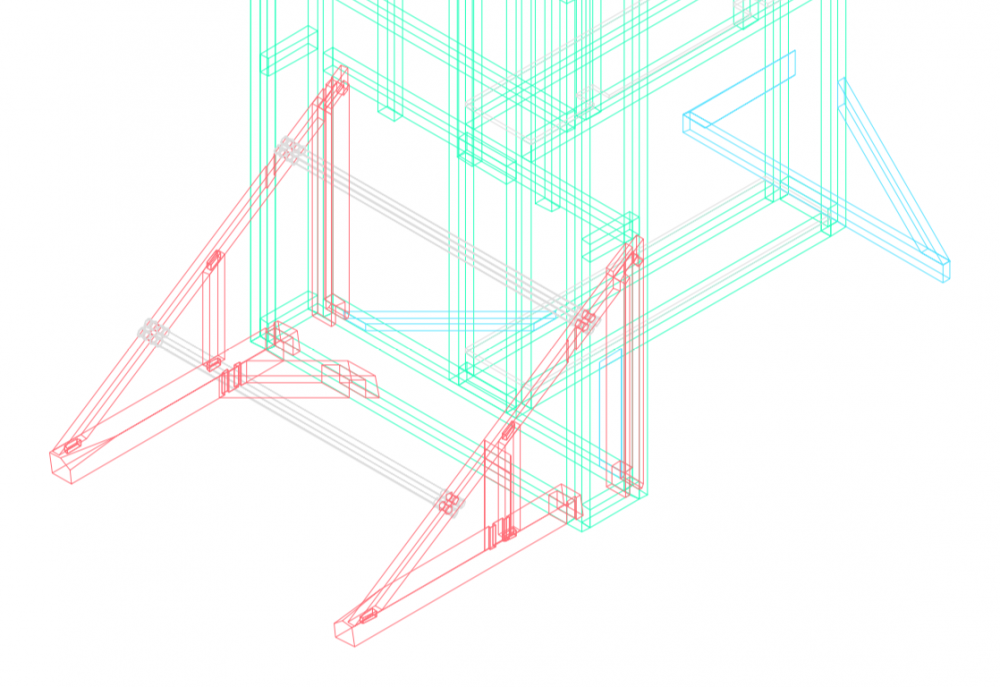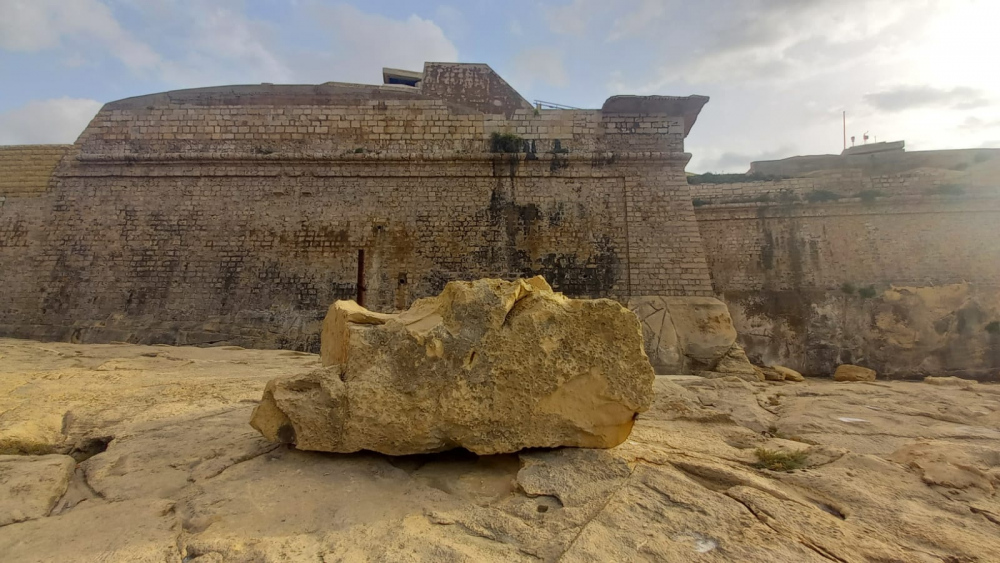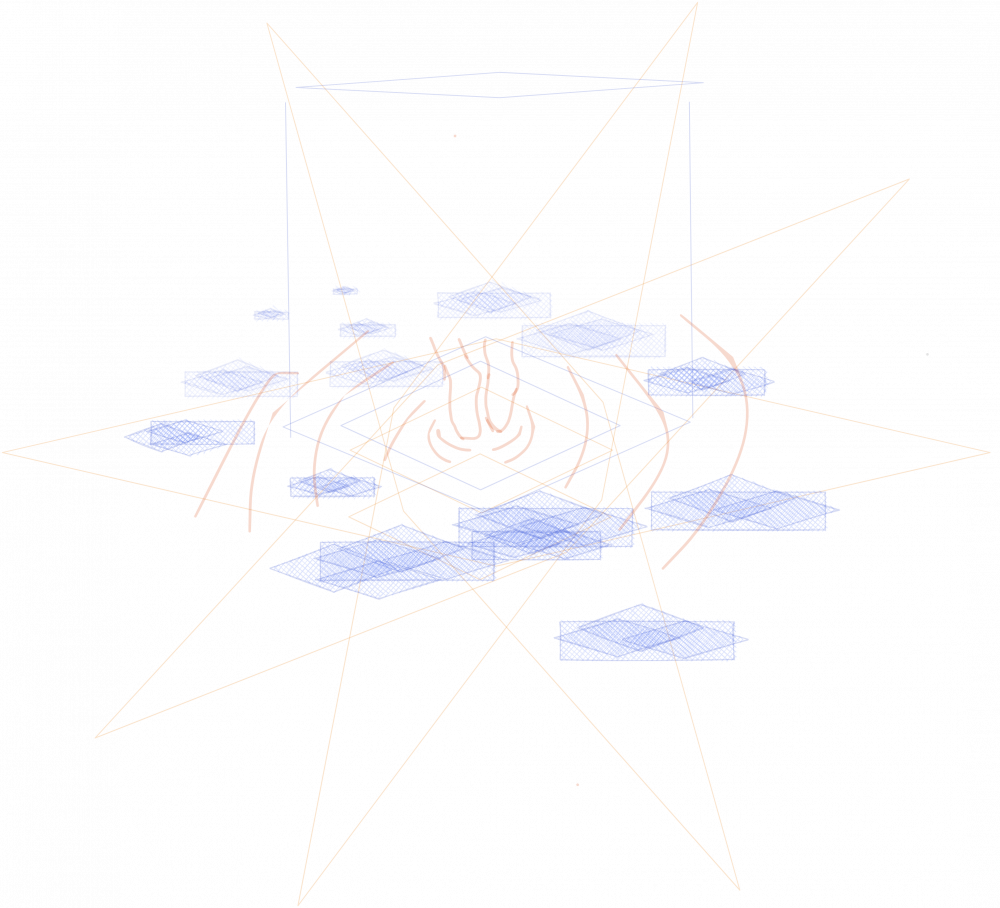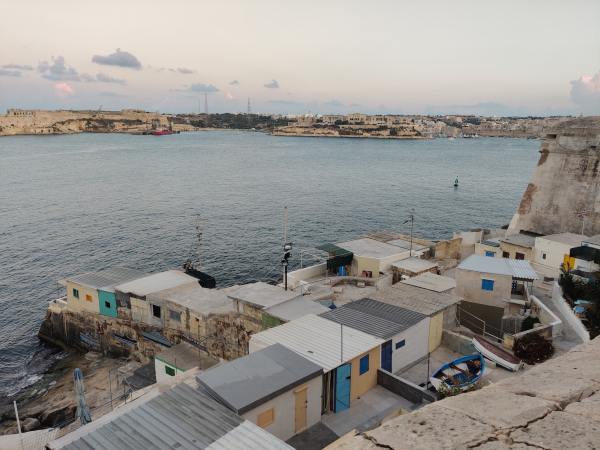The space is now defined by a large structure made of bare wood, steel, and textile. It sits in the auberge like a guillottine. Threre metres high, and intead of a basket it carries a deck made of cotton and patches of colour on cotton.
Wikiverse with Toni Sant
Stefan Nestoroski [Water]
flatpack riddle sculpture, maltese limestone and lime, standard brick dimensions 2021, to be found on manoel island until further notice
Temporary Show brings together a loose collective of artists for ad hoc
open to meet and work together, long term Collaborators who can run
can share more specific skills and techniques.
this slab doesn't even weigh 1MB
keystone
anchor
chain/rope
buoy,
staying afloat
Hold on to the air in your pockets // Halt dich an der Luft in deinen
There is a boulder at rest just across the Mina tal-Foss, locals can identify the boulder with the great storm of 1982. A few more boulders stand in your path on the way to the grandharbour. They are also identified by great storms in our lifetime. This includes minor but historical gale force winds, such as the one which swept over the Bush-Gorbachev Summit in the year of 1989, as well as a viral hurricane, such as lovinmalta's rendition of Xemxija and fish sprouting out of its shoreline in March 2019.
Ths narrative aims to investigate our relationship to a force majeure. Rather than stay passive and complicit with forces beyond our control, be it politics, climate or otherwise, the intention is to first, identify our place among others, such as your immediate community, and then go on to develop our personal reach with the making of an object of art as a catalyst.
Taschen fest.
The residency brings together the work of Johannes Buch and Aidan Celeste. They will use their skills in publication to revisit and curate a narrative with contributions from experts in heritage and maritime, as well as collaborations with other artists. This research will be used to contextualise their personal interventions around the Grandharbour, and focus on its relationship to great storms. How do we deal with such a radical force of nature? How does it shape our values and engagement?
The project takes place under the guise of a reading room in the Residency Space at MUZA. It will be the main site for the artists to engage their immediate community, and invite them to contribute through workshops, events, as well to present the design of a new site-specific intervention. this includes a close collaboration with Clive Vella (Airwars, UK) and Rakel Vella (https://r4k.club/), as well as contributions by Joanne Causon Deguara (Geologist, University of Malta), among other experts from maritime and heritage.
2807
Josephine Mamo w/o Emanuel, 2, alley 1 ,Valley road Birkirkara
44
NA
Reported that during todays heavy rains, a great flood of water forced open the door of her premises carried away Lm 250 in local notes and Lm 40 worth of clothing belonging to different persons and caused damages to furniture. GS230
signed(yes)no
NA
NA
oH buoy,
Moghod rapport tat-temp, u moghod tkun barra fix xita
2809
Vincent Scerri of Paul 5A Alley 3, Providence Balzan
55
Gs230 C.Briffa
Reported that during todays heavy rainfall, a great flood of water pased through his garden and damanged a great number of flowers, pots, plants, trees, and killed a quantity of his poultry.
signed: Yes(no)
NA
visit ^^&. 2826, POL.5244/5' W.2301/51/3/ M3011/51
George Farrugia 13 ta’ Ottubru 2012 · MARINE ONE landing with U.S. President George Bush Senior at the FREEPORT that memorable ( and stormy) day in 1989. Quite a treat seeing it all from the comfort of your own living room.
HOLD ON
IN YOUR POCKETS
Notes from Casa Lucrezia, Isla, October 2019.
If left untreated and in the wild, saltwater is carried on by waves beating against a cliff and eats its way through the stone up until it falls back into the water. This process is visible in the outermoast part of the archipelago, whereby, a jagged edge, colloquially known as 'Munxar', forms a thin strip of land marked by harsh winds sawing at its tip.
Galdies, C. (2011). The Climate of Malta: statistics, trends and analysis 1951-2010. National Statistics Office, Malta.
The presence of the surrounding water mass shapes significantly the climate of the Maltese Islands.The general weather is often cooler and more humid than what is experienced in inland areas of larger land masses. The high thermal capacity of the sea also reduces large fluctuations in the ambient temperature of the islands. But the presence of surrounding warm waters during the end of the summer season is a source of major weather instability when colder air migrates into the Central Mediterranean, thus creating areas with heavy thunderstorms and intense precipitation.
Advances of continental tropical air into the Central Mediterranean after a cold spell can give rise to active warm fronts, sometimes producing very active cumulonimbus clouds, copious rainfall and thunderstorm over the Maltese Islands. A period of sirocco in the Central Mediterranean, sometimes lasting for many days, often follows the first autumnal invasion of cold air.
Helmreich, S. (2015). Fluid Frontiers, Historicising Seas and Marine Life: Old Waves, New Waves. The White Horse Press, UK.
World War Two brought waves into relief as strategic entities, as oceanographers sought to predict wave action to smooth the amphibious landings of allied troops in Europe and Asia. In 1942, Scripps scientists Harald Sverdrup and Walter Munk were asked by the Oceanographic Section of the Army Air Force Weather Directorate to work on wave forecasting. Their report, Wind, Waves and Swell: A Basic Theory for Forecasting, published in 1943, ‘found that the size of waves did not depend solely on wind speed but was also affected by the size and shape of the body of water over which the wind blew (the fetch) and the length of time that the wind had been blowing (the duration)’ (Schlee 1973, 306; see also von Storch and Hasselmann 2010).
2811
fatal accident
insp: E.G> Gencini Gs230 C Briffa
At about 2.30 pm. A day which Lija Bus No 1990 was being driven by Paul Borg 49 years of. St. michael of no3 alley 1, st ro&*()_ B'Kara through Msida Road toawards B'Kara during the heavy rainfall on arriving halfway it developed engine trouble and while stalling...any the rainwater which was some feet high and which was passing down mannarino road and severl by-st^&* pushed it sideways - the a passenger ^&*... jupmped out and these two wer carried away by the current of water; sciluna got clear of water , &(Ibeing draged halfway down to msida, Galea was however picked up dead in msida.
two other %^& cars namely ^&13222, belonging to mrs brookes of modern imperial hotel, sliema and car no: 11712 of mr HE malloi of 195, tower road sliema, which were staionary at msida st. B'kara wrer also pushed away by the current damages, weecaused to both vehicles G.S.230
The movement is characteristic of a seesaw, a fishing rod, among other objects used to catch an object by throwing it's weight from one side to another. It feels playful, and its simple movement can mesmerise.
Who's catching who in this play of forces ?
#thatgloberigerinatho
Is Samuel fishing for waves, or are the waves fishing for Samuel ?
#leveragedevice
Dimeo, N. (2016). The Memory Palace, A Washington Monument.
Music
- We hear three pieces of Matthew Robert Cooper’s score to Some Days Are Better Than Others: Expectation, Drifting, and Katrina Outtake.
Notes
- If you want the story of the construction of the actual Washington Monument, you could check out John Steele Gordon’s book.
Cassar, J. Torpiano, A. Zammit, A. Cassar, JA. Micallef, A. Zammit, T. (2017). Proposal for the nomination of Lower Globigerina Limestone of the Maltese Islands as a "Global Heritage Stone Resource"
Build Up Ideation with
Rakel Vella
Kiet Bonnici
Sam Ciantar
Geo Location with Clive Vella
Limestone is a sedimentary rock, composed mainly of skeletal fragments of marine organisms such as coral, forams and molluscs. Its major materials are the minerals calcite and aragonite, which are different crystal forms of calcium carbonate (CaCO3).
experiments. These include a combination of Participants who are
workshops and interventions with our peers, and Contributors who
Samuel Ciantar is currently reading for a Masters in Architecture & Conservation at the University of Malta. He is interested in the thresholds of art practice, architecture & design. His work revolves around the new ways we can perceive our position within larger ecological processes. He is also part of the team at the Digitisation Unit for Heritage Malta, and takes an active part in self organised communities for the arts, including the Gabriel Caruana Foundation, community-driven projects (Fuse 2021) and activism through public space interventions
Supported by MUZA and The Arts Council Malta
Taschen fest.
Rakel Vella is an emerging artist at the far end of her dissertation for an MFA in Digital Arts (University of Malta, 2022). Her work engages with surveillance culture and adopts the use of interactive installation for a critical approach. She is also part of the team at the Digitisation Unit for Heritage Malta, and contributes to a loose network of artists and designers with an interest in 3D modelling, music, and visualisations, such as Aweful Club and the Insynk Collective.
Together with Johannes Buch, we first met with our collaborator, Clive
The idea was to create something which we can test out for on-site-lo
myself and Johannes presented our work over a Google-Meet, and sh
we can make, carry, and remove without a single trace in just a few ho
Vella and the artist, Rakel Vella (no_relation) to discuss interventions.
gistics as much as tease out narratives about the coastline. To do so
ared our experience of engaging others by practical interventions, stuff
urs - as light as a picnic.
Johannes Buch has a graphical practice and also skilled in exhibition design, photography, and curation. Johannes curates with the urban fabric by designing essential details. This often takes the shape of in-situ sculpture, among other disciplines, such as his contributions to the studio, FoAM Filfla, Anna's Weekend at Blitz Malta, and Fleeting Territories.
As an alumni of (nl)ArtEZ Institute for Art & Design, he studied Graphic Design in Arnhem, as well as Art & Communication Design in Enschede. In addition, he also holds a Master of Arts in Exhibition Design from HS Düsseldorf where he graduated by developing a multichannel cinematographic exhibition about Ethnographic Music and Film.
Aidan Celeste has a practice based in research, publication, and a set of artistic counterpoints. He developed this approach with the curatorial team for (nl)Data in the 21st Century in 2015. Essentially, it embeds the arts in real life scenarios and uses the gallery space as a intermediary space between its communities and the urban fabric. This practice now finds a host in his contributions as part of the curatorial team of (mt)FUSE, (eu)AMASS, and residencies within the urban fabric.
His approach aims to ask better questions and engage critically with the world around us. In Malta, this work included What Will Fall for Maren Richer’s Dal-Bahar Madwarha in 2018, his contribution to artist run projects, such as Elaine Bonavia’s [V]room of and Bettina Hutchek's Fragmenta Malta.
Kiet Bonnici is an artist and designer who engages both disciplines with a critical practice. His work intervenes in the social and political content carried by objects he remakes from each discipline. In addition, he works in fabrication with production teams for both feature film and exhibitions in the visual arts. Together with a strong network of peers he has contributed to Debatable Lands by Maren Richter and the Fleeting Territories, No Ordinary Terrain, and other activities for the arts, activism, and design.
Abigail Agius is an emerging artist living and working in Malta. She is interested in creating empathetic and playful work driven by physical experience. Her drawing reflects inner ways of being and aims to capture forms which feel liberated and naive. Her practice further involves working with textile and fibre, exploring hand-knitted wool, and using it as a means to engage with generational knowledge passed down through the women in her family. She is a graduate in Comparative Literature at Goldsmiths College in London and also works on projects in theater, film and community arts. Recently she has installed serp/ dudu as part of SPRING (v1.4) at the Gabriel Caruana Foundation, and is currently collaborating with Florinda Camilleri on place matter(s), a project for the upcoming show, Ordinary Lives of Women at Spazju Kreattiv in 2022.
Clive Vella is a sound artist, researcher and open-source investigator based in London (UK).
He currently works as Specialist Geolocation Researcher at Airwars, a UK-based NGO that tracks, assesses and archives military actions and related civilian harm claims in conflict zones across the Middle East. As a practitioner, Clive has liaised with representatives of the US Army, United Nations, and Amnesty International and has collaborated with Forensic Architecture and Bellingcat.
Previously, his background in sound studies led to the completion of his final MA project - an investigation into infrastructural changes during the Siege of Sarajevo through a sonic methodology of sniper mitigation tactics. While reading for his MA at the Centre for Research Architecture (CRA) at Goldsmiths University London, he participated in projects supported by Sonic Acts (NL) and conducted workshops on sound as a material event that can be used to understand dense urban environments.
IG @abiagius
Very fun week of textiles making a seat based on Rakel's rock collages for hold on to the air in your pockets with aidan and kiet at muza
TO THE AIR
Hold On is lead by Aidan Celeste and Johaness Buch. It takes place with the
Programme at MUZA. Participants were invited to learn about our artistic pro
more active role were invited to collaborate and develop their own variation o
and Abigail Agius, as well as guests who popped by to share and interpret t
These relationships are presented here as part of Temporary.Show, an online
space for ad-hoc collectives and the projects which bring them together. The page you are on splits the project in three chapters, Hold On which refers to preliminary search and surveys with communities,. institutions, and territories, To the Air and In Your Pockets, which refers to the cycle of taking an idea to a workshop, and developing it with a live interventions between MUZA and the coastline..
support of a Project Fund (Research) by the ACM and the Artist in Residency
cess by taking part in a set of workshops at MUZA. Those who took on a
f this practice. The list inlcludes the artists Kiet Bonnici, Samuel Ciantar
he objects we made on site.
TO THE AIR
IN YOUR POCKETS
.
.
.
.
Working with MUŻA provided a good point of contact with institutions, their communities, and experts from heritage and maritime. The organisation benefits from the interest of the sciences, the arts and humanities, as well as national patronage. It inherited this wealth as part of a change over in 2018. Formerly, it used to host the national collection of the fine arts and took on the role of a national museum on far side of Valletta, South Street. This collection is now part of MUŻA, and it has since moved to the Auberge D’Italie on Merchant Street. In it new location, it is now flanked by the seat of government, the parliament, and La Vallette Square. The wealth it carries has its own baggage of old museums and colonialism. Switching to MUŻA was the first step in opening up this organisation, and their aim is now to make room for a more communal engagement as well as diversity.
I feel that Hold On challenges this organisation on its own merits and its audiences. How does a traditional museum make room for new communities to take shape? An open culture of engagement? As part of a much wider network of governance, decisions at MUZA are generally top down, unquestionable, and hierarchic. Likewise, audiences are used to the comforts of a gatekeeper. They are at ease and generally fall in line with the crowd at hand. These directions are unmovable, hierarchic, and change has to take place at every level before it is executed. In contrast to large organisations, small communities are horizontal and act quickly. They benefit from one-on-one contact and personal responsibility, whereby the same person who takes a decision is also the same person who acts on it.
In times of crises, the ability to crossout a hierarchy and work in favour of immediate action is essential. The grey zones of Valletta thrived under the pandemic. In contrast to the central areas, communities organised themselves on the sideline. People met up in unused lots for a picnic, ad hoc communities came together for an evening, and also disappeared overnight. The project aims to learn from small communities and how to live with a Force Majeure, be it on the coastline, such as a gale force wind, as much as the politics of a museum and its governance. How do you work with an unmovable force? A direction that once takes place, you have to accept? Passive engagement makes us complicit. Within the context of a crowd at a museum, you still follow through and tow the line. To get over this curve, we invited participants to first, break this behaviour, and then go on to make the place one's own.
[The Residency Space]
For the month of December, MUZA provided a hall to work from as artists in residence. The Residency Space sits between the end of their Collection and the Gift Shop. It has no clear exit, and feels more like a boardroom than a community space. The room is an old hall. It is defined by stiff furniture, heavy marble, and solid wood. Generally, artists use the space for temporary shows and cover it up. They throw curtains over the marble plaque, turn down the lights, and build panels to block up access to the furniture at the back. To keep this project grounded in something real, we opted to take this perception of a boardroom to an extreme.
Together with Johannes, we identified a few other objects that can heighten this perception. The objects included a few walls, plinths, and fabric. They were built by MUZA for a historical exhibition of paintings by Old Masters. The paintings were donated by a Russian Oligarch, and MUZA inaugurated this accession with a national platform. Ministries, Institutions, and Embassies joined the platform to support this activity. Likewise, the walls we adopted were decorated to fit a national platform and just as monumental. They are made of wooden lengths, and covered in the red fabric of Damasc. Generally, this type of red fabric is used as a sign of prestige. In more traditional circles, such as museums, titular feasts, and the powers that govern Malta, it is used for national events. It can feel royal and rather exclusive to step into a room covered in such a fabric and its pattern.
On the condition that we do not dismantle, nor damage the objects, MUZA lent us a set of 03 walls for the Residency Space. Once the red fabric is removed, the walls take on a more practical role, and simply turn into a scaffold made of wood. We looked at each wall as a support structure, a scaffold, a spine to support you, and instead we used its ribs as an ad-hoc workbench. How do you work with such a condition instead of against it ? You cannot touch it, but you can still use the monument and the value it carries as socio-political object in itself. To do so, we invited Kiet Bonnici and Abigail Agius to develop their participation into a collaboration. They are both artists who’s engagement is playful, and still critically engages with the political and social value of an object. We opted to create support structures, and to to find a way to work with this condtion as a design challenge in itself
The first workshop at MUZA took place on site, and participants were invited to collaborate and turn the exhibition space into a Reading Room, a place to meet, work, and open discussion.
MUŻA is the National Museum of Art, branded as the Malta National-Community Art Museum. The word MUŻA is a translation of the Maltese word for ‘inspiration’ and also stands as an acronym for MUŻ(ew Nazzjonali tal-)A(rti), in English – National Museum of Art. It also refers to the muses, the mythological figures from Classical Antiquity inspiring creativity and, in effect, the etymological source of the word, ‘museum’.
Saussure blocked the way for meaning to be understood as the outcome of a correlation between a sound (or word) and an object for which the word is the label. Rather, meaning came to be seen as the result of an entire system by which the use of that word, say, rock, can be deployed instead of a large set of possible alternatives or substitutions, say, stone, boulder, pebble, crag, agate, lump of ore . . . . The choice one makes within this system of substitutions betrays a whole array of assumptions keyed to vastly different vocabularies: of scale, of technical (geological) mastery, of picturesque emotion, of verbal precision or generality. There is a system of interrelated difference , and in order to enter this system the word rock cannot be tied uniquely to this lump of matter at one's feet. Meaning is not the label of a particular thing; nor is it a picture of it. Meaning, for the structuralist, is the result of a system of substitutions
Rosalind Krauss on Saussure
Rough Dawings of Structure (03)
from Valletta Coastline
Rubble Orbit, Grand Harbour, Valletta, Johannes Buch, 2018
Variation with live feed across through structures, Aidan Celeste
.





























